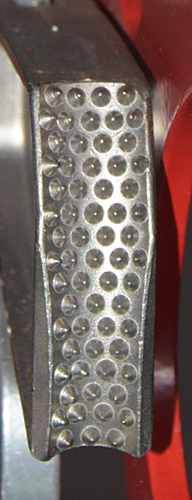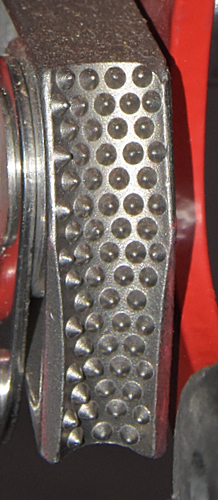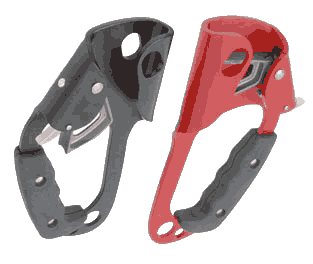Overview
[ Top
| Version B
| Return to H.E.C. Ascenders
]
Version A
(#1541)
Technical Details
I acquired my Hugh Banner, Version A from G. Wright in 2010.
Version A is 192 mm. tall, 99 mm. wide, 28 mm. thick, and weighs 241 g.
The shell is a tall irregular shaped stamping made from 4.2 mm. aluminum alloy sheet metal. A 17 mm. wide rope channel is formed in the
upper portion of one side and a smaller cam channel lies opposite. A hole drilled through both sides of the cam channel
accepts a 5 mm. rivet. The cam and cam spring are mounted
on this rivet.
The handle below the cam has a soft "rubbery" two-piece
hand grip riveted into place. The hand grip has four shallow finger
grooves. A 15.0 mm. sling attachment hole is punched below
the handle opening, and a 9 mm. hole is punched below and
outside the first. A 14.8 by 21.1 mm. oval hole through both
sides of the rope channel provides an attachment point just above
the cam. A curved 16.7 by 32.3 mm. slot behind the cam reduces the ascender’s weight. There is no cam stop.
 The cam is a plated skeletonized steel casting. The cam has
number of small conical teeth, all of which have their axes approximately
in line with the corresponding radius from the cam pivot. The cam radius increases from 43 to 60 mm. over an angle of 37°, giving a 26° cam angle. The
tooth pattern is (4.5)^4(4.3)^4. small nubbins surrounding the cam axle help keep the cam centered in its channel. Two notches on the cam engage the safety mechanism to hold the cam open.
The cam is a plated skeletonized steel casting. The cam has
number of small conical teeth, all of which have their axes approximately
in line with the corresponding radius from the cam pivot. The cam radius increases from 43 to 60 mm. over an angle of 37°, giving a 26° cam angle. The
tooth pattern is (4.5)^4(4.3)^4. small nubbins surrounding the cam axle help keep the cam centered in its channel. Two notches on the cam engage the safety mechanism to hold the cam open.
The safety mechanism consists of several parts. A safety trigger, sear, and trigger spring are mounted on a 2 mm. rivet below and outside the cam rivet. The trigger is cut from 6.3 mm. aluminum. The inner end keeps the cam from opening until one depresses the trigger. The sear is stamped from 1 mm. stainless steel. The lower end is a channel with two notches that engage the safety rivet, allowing the sear to rotate. A coiled sear spring holds the upper end against the cam. The sear spring sits in a stamped cap that fits into a hole in the cam channel (this cap is barely visible in the photographs). When the cam is fully open, sear engages the outer notch on the cam. Depressing the trigger forces the sear away from the cam, releasing the cam and alowing it to close.
The front of the ascender isstamped "N8994." The back is printed with
a design, the HB icon, "WALES," an arrow with "UP,"
"Ø 8-13mm," "CE0086 EN 567," "NFPA
1983 (2001)," the letter "L" inside a circle, and
the UIAA logo.
|
 |
My Version A is a left-handed ascender. If you have
a right-handed Version A that you are willing to part with, please
email me. |
|
The primary difference between Version A and Version B is the safety. Opening and locking the cam may seem like a two-handed operation at first, but one soon learns how to do it single-handed. The problem with the safety mechanism is that its complexity makes it susceptible to jamming in muddy conditions. While it works well when kept clean, the locking mechanism is unreliable in muddy conditions.
My "non-safety-related" comments on Version B apply to Version A as well.
[ Top
| Version A
| Return to H.E.C. Ascenders
]
Version B
(#199)
Technical Details
I acquired this pair of ascenders from John Bull Clothing in
August 2005.
Version B is 191 mm. tall, 93 mm. wide, 39 mm. thick, and weighs 274 g.
 The shell is a tall irregular shaped stamping made from 4.2 mm. aluminum alloy sheet metal. A rope channel is formed in the
upper portion of one side and a smaller cam channel lies opposite
the first. The rope channel is 18 mm. wide. A hole drilled through both sides of the cam channel
accepts a 6 mm. rivet. The cam and cam spring are mounted
on this rivet, along with a flat washer on each side of the cam.
The handle below the cam has a soft "rubbery" two-piece
hand grip riveted into place. The hand grip has four shallow finger
grooves. A 15.8 mm. sling attachment hole is punched below
the handle opening, and a 9 mm. hole is punched below and
outside the first. A 14.8 by 21.1 mm. oval hole through both
sides of the rope channel provides an attachment point just above
the cam. There is no cam stop.
The shell is a tall irregular shaped stamping made from 4.2 mm. aluminum alloy sheet metal. A rope channel is formed in the
upper portion of one side and a smaller cam channel lies opposite
the first. The rope channel is 18 mm. wide. A hole drilled through both sides of the cam channel
accepts a 6 mm. rivet. The cam and cam spring are mounted
on this rivet, along with a flat washer on each side of the cam.
The handle below the cam has a soft "rubbery" two-piece
hand grip riveted into place. The hand grip has four shallow finger
grooves. A 15.8 mm. sling attachment hole is punched below
the handle opening, and a 9 mm. hole is punched below and
outside the first. A 14.8 by 21.1 mm. oval hole through both
sides of the rope channel provides an attachment point just above
the cam. There is no cam stop.
The cam is a plated skeletonized steel casting. The cam has
number of small conical teeth, all of which have their axes approximately
in line with the corresponding radius from the cam pivot. The cam radius increases from 43 to 60 mm. over an angle of 37°, giving a 26° cam angle. The
tooth pattern is (4.5)^4(4.3)^4. A spring-loaded manual safety
bar is bolted to a cylindrical cam inset. The normal action of
the spring holds the safety against the cam. When the cam is opened,
the shell interferes with the safety bar, thus preventing opening
the cam. If the safety bar is moved away from the cam (opposing
the spring), it will clear the shell and the cam will open. At
full open the safety can be released and the spring will hold
the safety against the back of the shell. This provides a means
of locking the cam open. A pin on the safety assists in operating
the safety mechanism.
The front of the left and right ascenders are stamped "N778"
and "N774," respectively. The back is printed with
a design, the HB icon, "WALES," an arrow with "UP,"
"Ø 8-13mm," "CE0086 EN 567," "NFPA
1983 (2001)," the letter "L" inside a circle, and
the UIAA logo.
The Hugh Banner is essentially the same ascender as the PMI Cat, except that the bolt attaching
the safety to the cam is much smaller. The Hugh Banner is about
14 grams lighter - which I cannot explain.
They are well-made ascenders and perform much like the Petzl Ascension. All sharp edges have been
removed. The attachment points are simply holes in the shell, and
although rounded they should have been beveled more; even so,
I would consider their small radius too sharp for directly attaching
sling ropes. They are probably acceptably rounded for webbing
(or could be made so), but considering the proximity of the attachment
points to the main rope, I would recommend using a small maillon
for most attachments in order to reduce the risk of sling abrasion.
The lower attachment hole could theoretically have the same safety
problems as the one on Clog Version A.
The upper rope attachment hole is located very close to the main
rope. A carabiner through the upper attachment hole will probably
drag on the main line. Note that such a carabiner will prevent
putting the ascender on or off rope, so one’s climbing system
must be designed accordingly.
 The
safety is one of the easiest to use with one hand. The Hugh Banner
web site showed a different safety design on their ascender, similar
to that found on the Clog Expedition
and CMI Expedition ascenders (see photo
at right, taken and modified from that site). I was disappointed
to receive what amounts to a duplicate of the PMI
Cat instead of a different ascender, but the safety on the
Hugh Banner I received (and PMI Cat)
is so much easier to use one-handed than the ones on the Clog
Expedition and CMI Expedition ascenders
that I prefer the new design.
The
safety is one of the easiest to use with one hand. The Hugh Banner
web site showed a different safety design on their ascender, similar
to that found on the Clog Expedition
and CMI Expedition ascenders (see photo
at right, taken and modified from that site). I was disappointed
to receive what amounts to a duplicate of the PMI
Cat instead of a different ascender, but the safety on the
Hugh Banner I received (and PMI Cat)
is so much easier to use one-handed than the ones on the Clog
Expedition and CMI Expedition ascenders
that I prefer the new design.
The ribbed handle is not comfortable for me because the ribs
are spaced poorly for my hand. In addition, the handle is too
square. A file can eliminate both objections. The rivets holding
the cam to the frame are countersunk more than those on my PMI Cat. The cam is very well made, and
the teeth are reasonably sharp (unlike those on my PMI
Cat).
This ascender has the same pit lip disadvantage as the Clog and other stamped frame ascenders.
The shell is thicker that the one on the Camp
Pilot, Kong-Bonaiti, and Petzl
Ascension but it isn't reinforced as it is on those.
I'm not sure the extra holes are needed at the base. Except for the Petzl Pompe, I've never found a real need for a second hole. Some people like them, and I might find them more appealing if they were large enough for a standard carabiner to fit through.
If you are looking for a stamped-frame handled ascender, the
Hugh Banner is yet another a reasonable choice to consider.
[ Top
| Version A
| Version B
]



 The
safety is one of the easiest to use with one hand. The Hugh Banner
web site showed a different safety design on their ascender, similar
to that found on the
The
safety is one of the easiest to use with one hand. The Hugh Banner
web site showed a different safety design on their ascender, similar
to that found on the